Where are we heading? The future direction of location-powered advertising in a privacy-first world

Our industry is at a real inflection point with Google’s demise of the cookie and Apple’s changing IDFAs (Identifier for Advertisers). While this will have far-reaching implications, the future looks bright for location-powered advertising, as Emma-Jayne Owens writes.
No tap dancing - it’s privacy first
Let’s start with us – as consumers. What do we get out of all of this when we find ourselves in a new world of choice relating to our privacy and identity online? The first thing we get is more control. Giving people more transparency and control over their own data and privacy is the right move for the industry. Many would say it’s been a long time coming and why has it taken so long anyway?
How will 'we humans' react to the latest Apple privacy changes? The reality is we really don't know and can't predict this.
And that’s because first and foremost, it’s about choice. And we don’t all react the same way to the choices we’re given. For some of us, who never want to order an Uber, don’t fancy a home delivered meal or refuse to head out on an app-generated date, we might choose to disable precise location tracking on our devices.
For those who find even one of these things compellingly convenient, we probably won’t.
Consent is the new gatekeeper
The changing world of Apple identifiers also requires something else compelling – good reason for tracking you across apps and websites. Consent dialog popups will be the gatekeepers of permission and publishers will need to prove their value in getting you to press ‘accept’. This is a good thing – for consumers, publishers and marketers – but there is a big education job to do around this to help consumers understand their options.
It’s also important to remember, before we all run for the hills and decry location advertising entirely, those changes to identifiers only affect Apple OS, so only those with an Apple device and only those who choose to change location permissions for tracking on their Apple device will get less targeted advertising.
Advertising works — but targeted advertising really works
The angst around disappearing cookies and the impact of a changing mobile ecosystem is fairly evident. Because accurate data and precision targeting is key to ensuring efficient and effective advertising campaigns.
Any way you cut it, how we plan, activate and measure highly targeted campaigns will be disrupted by the changes.
How much disruption depends on the adoption (or otherwise) of industry-wide alternatives in the future.
Dominating many conversations right now is just how marketers will find smarter ways to leverage both the opted in and anonymous web to continue to run effective and high-performing media campaigns.
And marketers are understandably nervous. A recent survey conducted by Blis showed that 78% of senior marketers are concerned or very concerned by the loss of cookies, whilst 61% feel the same about the reduction of IDFAs.

A recent survey conducted by Blis showed that 78% of senior marketers are concerned or very concerned by the loss of cookies, 61% feel the same about the disappearance of IDFAs
Research tells us that marketers still want access to meaningful audiences to drive business results. Why just target people searching for the latest footy scores when you could reach young, health-conscious sports fans who routinely go to the gym and spend often on health food?
Is this still possible in the new world of privacy? Absolutely. It will require a change in approach though. For location-based targeting, at least, we need to move beyond the tightly held obsession with device counts and personal data alone for targeting and support the possibility of highly indexing audiences, built for statistical relevance, activation and ultimately (because this is what makes the world go round) results.
Competing revolution solutions
Does one size fit all? Nope.
There are several different solutions emerging to tackle the changing world head on. First-party data, open-source universal IDs, the renaissance of contextual targeting and “cohorts” within Google’s Privacy Sandbox have appeared as the front runners.
Will any one of these be the ultimate answer for the future of our industry? The debate is ongoing, although it’s unlikely only one solution will solve the challenge of cookie-less privacy-first targeting.
As for the mobile landscape, Apple reducing rather than removing identifiers has also seen robust debate around the expected impact of this change. Last month, Facebook announced their ‘fight back’ against Apple with their plans to prompt users to accept tracking in exchange for more personalised ads and the chance to support businesses that rely on ads to reach customers.
And many other publishers and developers have been preparing to better articulate their value exchange to consumers who will be armed with even more choice.
The key to finding and adopting potential solutions, as we navigate the road ahead, is to keep privacy, transparency and choice for the consumer at the heart of our thinking.
Location, location, location
It matters, and not just when thinking about buying an overpriced two-bedder with no parking in a vaguely interesting suburb.
Location is not dead. It’s not even on life support. It is, however, staring down a real inflection point along with the rest of the industry. A challenge we should be compelled to rise to, of course.
Of note is that location data actually has much less reliance on cookies than other methods of targeting. Changes with IDFAs will impact Apple users across the market, however location data as a means to understand real human behaviour is as strong as it ever was.
What people actually do, not just what they say they do, is a better indicator of intent than any other form of data. And some partners, like Blis, will continue to invest in highly accurate, consented, first-party location data.
The key for the new world is how we move beyond a reliance on personal data alone – and combine it with aggregated and anonymised behavioural and lifestyle signals – to offer a much deeper understanding of consumers.
Doing so helps us to future proof targeting, create dynamic and highly relevant audiences and deliver the statistical relevance needed for scale, activation and results. And after all, that’s still what we’re all in the business of delivering.
So as we all head bravely into the perfect adtech storm with seemingly inadequate wet weather gear (like we had a choice), let’s not talk ourselves into going down with the boat.
There are still plenty of reasons to believe (and prove!) that location-powered advertising has the means to go the distance. The optimists among us would say it’s time to challenge, change, reimagine and reinvent for a privacy-first world because that’s exactly what’s needed to weather this storm.
